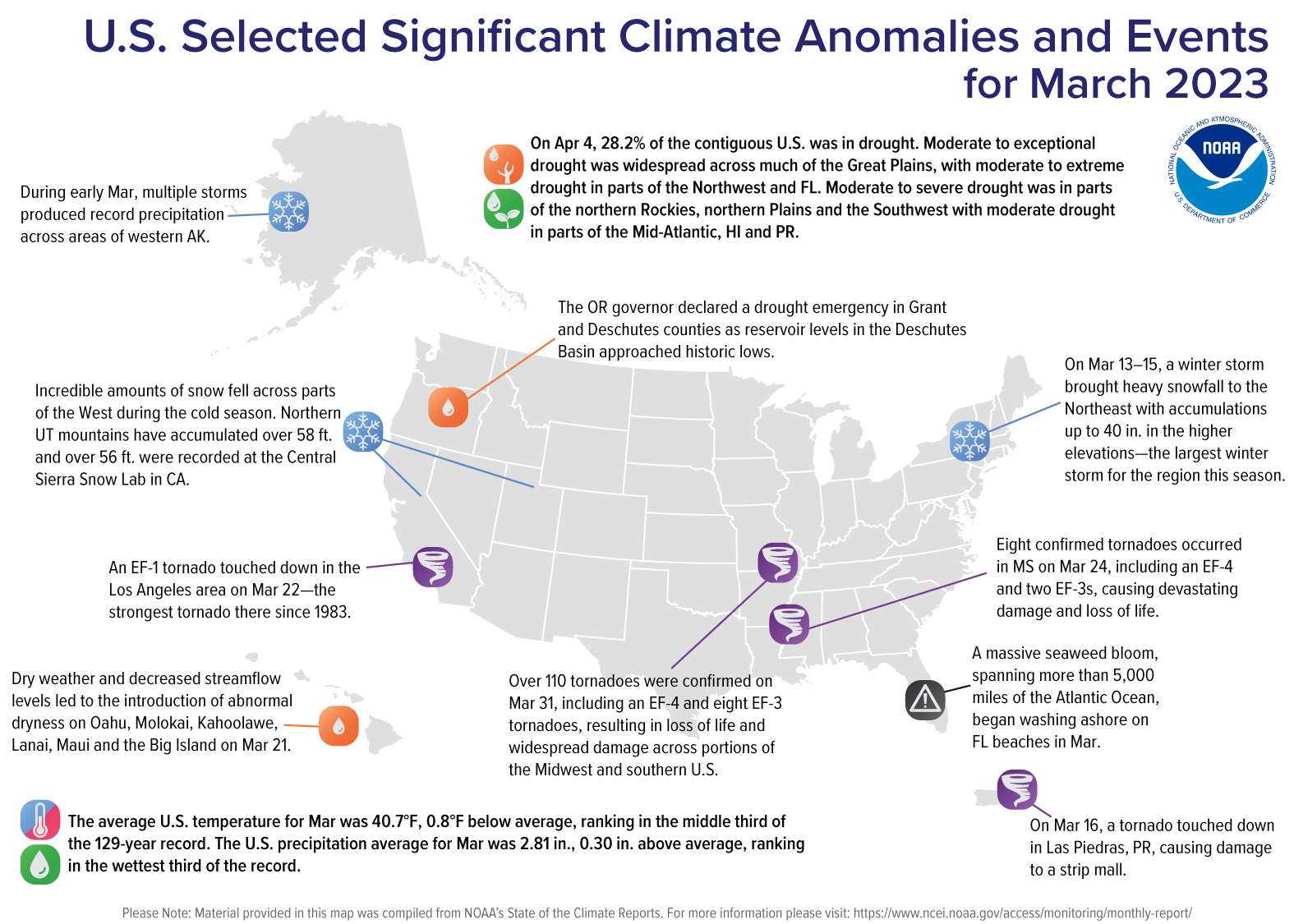April 10, 2023 - March was a turbulent month weather-wise across the United States, as a series of western storms brought record amounts of precipitation and tornadoes ripped through parts of the South and the nation’s midsection.
Below are more takeaways from NOAA’s latest monthly U.S. climate report:
Climate by the numbers
March 2023
The average monthly temperature across the contiguous U.S. was 40.7 degrees F (0.8 of a degree above the 20th-century average), which ranked in the middle third of the 129-year climate record.
Temperatures were above average from the southern Plains to New England and in parts of the Great Lakes. Florida had its eighth-warmest March on record.
Below-average temperatures were recorded from the northern Plains to the West Coast, with Oregon seeing its third-coolest March, and California, Nevada and North Dakota each having their fifth coolest.
The average precipitation in the contiguous U.S. last month was 2.81 inches (0.30 of an inch above average), which ranked in the wettest third of the climate record.
Precipitation was above average across much of the West, from eastern Oklahoma to the Great Lakes and in parts of the northern Plains and the Northeast. Utah ranked third wettest, while Nevada and California had their sixth- and seventh-wettest March on record, respectively.
Below average precipitation was experienced from eastern New Mexico to the central Plains, in the Mid-Atlantic, and in parts of the Northwest, Gulf Coast and Northeast. Virginia had its eighth-driest March in the climate record.
Year to date | January through March 2023
The average contiguous U.S. temperature for the year to date was 37.4 degrees F (2.3 degrees above average), ranking as the 20th-warmest such YTD on record.
Florida, Georgia, North Carolina, South Carolina and Virginia each had their warmest January–through-March period on record. Meanwhile, Alabama, Connecticut, Delaware, Maryland, Massachusetts, New Hampshire, Ohio and Vermont each had their second warmest.
The average precipitation for the first three months of 2023 was 7.75 inches — 0.79 of an inch above average — ranking in the wettest third of the historical record.
Wisconsin and Utah each had their third wettest such YTD, Nevada saw its eighth wettest, and California, Michigan and Arkansas each saw their 10th wettest. Meanwhile, Maryland and Delaware ranked third and fifth driest on record, respectively.

Other notable climate events from this report
- Rounds of storms brought heavy rain and snow. Since October 1, 2022 — when the water year begins for most of the West Coast — 31 atmospheric rivers (ARs) came through the region, according to the Scripps Institution of Oceanographyoffsite link. Several ARs struck in March 2023, bringing heavy rain and snowfall to much of the West. According to the California Department of Water Resources, the statewide snowpack was among the deepest ever recorded for the end of March — 237% of normal. Drought conditions in the West improved from 73.5% coverage on November 1, 2022, to 30.9% on April 4, 2023, according to the U.S. Drought Monitoroffsite link.
- Tornadoes took their toll. Several severe weather outbreaks produced deadly and destructive tornadoes last month that killed more than 40 people.
- March 1–3: A tornado outbreak swept through portions of the Ohio River Valley, southern Plains and Southeast. A total of 36 tornadoes, including two EF-2 tornadoes, was confirmed by NOAA’s National Weather Service.
- March 24–26: Tornadoes caused catastrophic damage in Tennessee, Mississippi, Alabama and Georgia. NOAA confirmed a total of 41 tornadoes including one rated an EF-4 and three rated as EF-3s.
- March 31: A widespread and deadly tornado outbreak ravaged portions of the Midwest and southern U.S. NOAA confirmed more than 110 tornadoes — the largest outbreak in a 24-hour period for the month of March.
- Billion-dollar disasters: During the first quarter of 2023, the U.S. did not incur any confirmed billion-dollar weather and climate disasters, though several extreme events are being evaluated at the time of this report.
- In early April 2023, NOAA’s NCEI added an additional seven historical weather and climate events which, after inflation and review, surpassed the billion-dollar threshold. The U.S. has now sustained 348 separate weather and climate disasters since 1980 where overall damages/costs reached or exceeded $1 billion each (based on Consumer Price Index adjustment to 2023). The total cost of all 348 disasters is estimated at more than $2.510 trillion.
More > Read NOAA’s latest climate report, and download the images.
Source: NOAA








